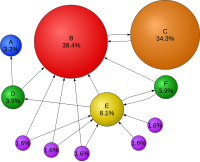
Photo from wikipedia
Abstract One of the most interesting challenges in network science is to understand the relation between network structure and dynamics on it, and many topological properties, including degree distribution, community… Click to show full abstract
Abstract One of the most interesting challenges in network science is to understand the relation between network structure and dynamics on it, and many topological properties, including degree distribution, community strength and clustering coefficient, have been proposed in the last decade. Prominent in this context is the centrality measures, which aim at quantifying the relative importance of individual nodes in the overall topology with regard to network organization and function. However, most of the previous centrality measures have been proposed based on different concepts and each of them focuses on a specific structural feature of networks. Thus, the straightforward and standard methods may lead to some bias against node importance measure. In this paper, we introduce two physical processes with potential complementarity between them. Then we propose to combine them as an elegant integration with the classic eigenvector centrality framework to improve the accuracy of node ranking. To test the produced power iteration ranking (PIRank) algorithm, we apply it to the selection of attack targets in network optimal attack problem. Extensive experimental results on synthetic networks and real-world networks suggest that the proposed centrality performs better than other well-known measures. Moreover, comparing with the eigenvector centrality, the PIRank algorithm can achieve about thirty percent performance improvement while keeping similar running time. Our experiment on random networks also shows that PIRank algorithm can avoid the localization phenomenon of eigenvector centrality, in particular for the networks with high-degree hubs.
Journal Title: Physica A: Statistical Mechanics and its Applications
Year Published: 2018
Link to full text (if available)
Share on Social Media: Sign Up to like & get
recommendations!